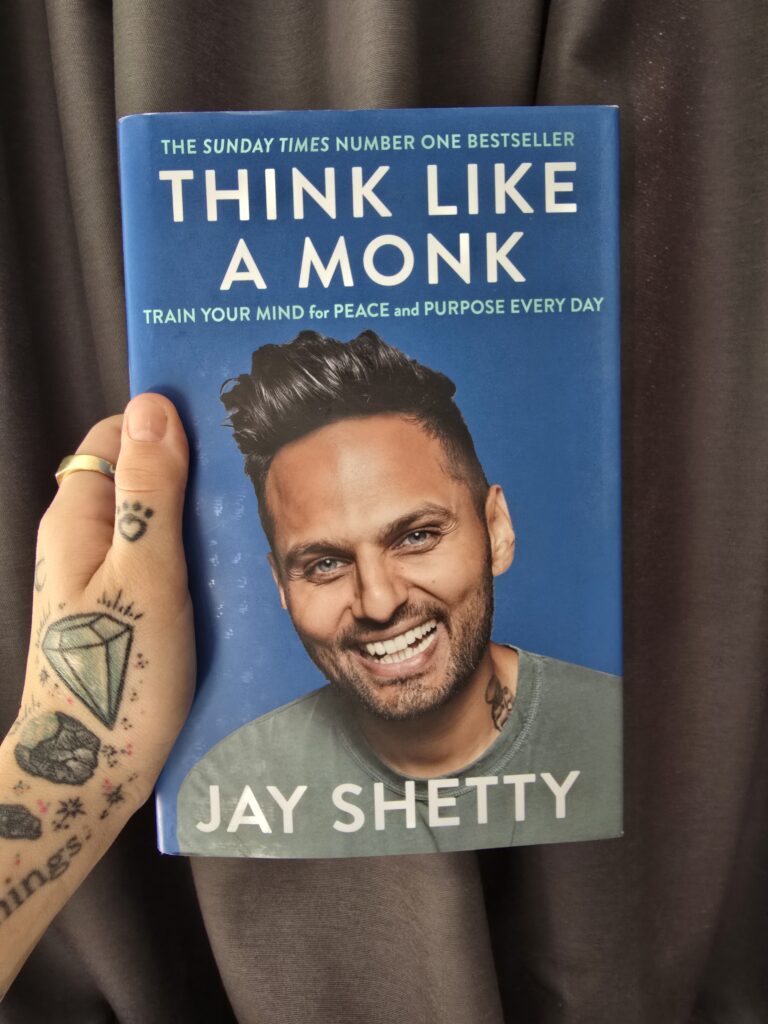
🇬🇧
A little summary :
In Think Like a Monk, Jay Shetty, a former monk turned motivational speaker and author, shares the lessons he learned during his time living in a monastery. The book is structured around three main areas of life: letting go, growing, and giving. Shetty uses his experience as a monk to guide readers through practices that can help them develop a calmer, more focused, and more fulfilling life.
The book begins with a discussion on the power of the mind and how our thoughts shape our reality. Shetty encourages readers to silence the constant chatter of the mind, which often leads to stress and confusion. He introduces concepts like mindfulness, meditation, and the importance of self-awareness to help clear mental clutter. Shetty emphasizes that our environment, such as the people we interact with and the media we consume, greatly impacts our mental state, and by choosing positivity, we can better control our thoughts.
Shetty’s first core principle is letting go, which involves releasing negative thoughts and habits that hold us back. He suggests that we should learn to detach ourselves from material things, toxic relationships, and our attachment to outcomes. Letting go also includes overcoming fears and limiting beliefs that prevent personal growth. This principle invites readers to embrace change and uncertainty as essential parts of growth.
Next, Shetty explores the concept of growing, which involves developing virtues such as gratitude, kindness, and resilience. By practicing these qualities, individuals can cultivate a mindset that leads to long-term happiness and well-being. He explains how monks focus on developing these traits through daily routines and reflections. Shetty highlights the importance of continuous self-improvement, suggesting that growth is a lifelong process.
Finally, Shetty discusses giving, the ultimate goal of leading a monk-like life. He believes that contributing to the well-being of others—whether through kindness, service, or sharing wisdom—leads to greater fulfillment. Giving is portrayed not as a sacrifice but as a pathway to deeper connection and purpose.
Throughout the book, Shetty blends ancient wisdom with modern science and real-world examples, making the teachings accessible and applicable to anyone, regardless of background or beliefs. Think Like a Monk offers a roadmap for transforming one’s mindset, achieving inner peace, and living a more meaningful life by adopting the principles of monkhood.
I found it a really nice book to read and I even underlined something in the introduction of the book, it was : I felt the urge to be around people who had the values I wanted, not the things I wanted.
And these 2 lists I found very handy and interesting! (I did not put the whole list here)
Monkey Mind Monk Mind
complains, compares, criticizes Compassionate, caring, collaborative
overthinks and procrastinates Analyzes and articulates
distracted Disciplined
demanding and entitled Enthusiastic, determined, patient
self-centered and obsessed Self-care for service
looks for pleasure Looks for meaning

🇳🇱
In Think Like a Monk deelt Jay Shetty, een voormalig monnik die nu een motiverende spreker en auteur is, de lessen die hij leerde tijdens zijn tijd in een klooster. Het boek is opgebouwd rond drie belangrijke levensgebieden: loslaten, groeien en geven. Shetty gebruikt zijn ervaring als monnik om lezers te begeleiden met praktijken die hen kunnen helpen een kalmer, meer gefocust en vervuld leven te leiden.
Het boek begint met een discussie over de kracht van de geest en hoe onze gedachten onze werkelijkheid vormen. Shetty moedigt lezers aan om de constante ruis in de geest te verminderen, wat vaak leidt tot stress en verwarring. Hij introduceert concepten zoals mindfulness, meditatie en het belang van zelfbewustzijn om mentale rommel op te ruimen.
Shetty benadrukt dat onze omgeving, zoals de mensen met wie we omgaan en de media die we consumeren, een grote invloed heeft op onze mentale toestand, en door positiviteit te kiezen, kunnen we onze gedachten beter controleren.
Shetty’s eerste kernprincipe is loslaten, wat inhoudt dat we negatieve gedachten en gewoonten loslaten die ons tegenhouden. Hij suggereert dat we moeten leren ons los te maken van materiële dingen, toxische relaties en onze gehechtheid aan resultaten. Loslaten omvat ook het overwinnen van angsten en beperkende overtuigingen die persoonlijke groei verhinderen. Dit principe nodigt lezers uit om verandering en onzekerheid te omarmen als essentiële delen van groei.
Vervolgens verkent Shetty het concept van groeien, wat inhoudt dat we deugden zoals dankbaarheid, vriendelijkheid en veerkracht ontwikkelen. Door deze eigenschappen te oefenen, kunnen mensen een mindset cultiveren die leidt tot langdurig geluk en welzijn. Hij legt uit hoe monniken zich richten op het ontwikkelen van deze deugden door middel van dagelijkse routines en reflecties. Shetty benadrukt het belang van voortdurende zelfverbetering en stelt dat groei een levenslang proces is.
Tot slot bespreekt Shetty geven, het uiteindelijke doel van het leiden van een monnikachtig leven. Hij gelooft dat bijdragen aan het welzijn van anderen—of het nu gaat om vriendelijkheid, dienstbaarheid of het delen van wijsheid—leidt tot grotere vervulling. Geven wordt gepresenteerd niet als een opoffering, maar als een pad naar diepere verbinding en betekenis.
Door het boek heen mengt Shetty oude wijsheid met moderne wetenschap en voorbeelden uit de praktijk, waardoor de leerstellingen toegankelijk en toepasbaar zijn voor iedereen, ongeacht achtergrond of overtuigingen. Think Like a Monk biedt een routekaart voor het transformeren van iemands mindset, het bereiken van innerlijke rust en het leiden van een meer betekenisvol leven door de principes van monniken te omarmen.
Ik vond het een heerlijk boek om te lezen, en in de introductie had ik zelfs al wat onderstreept, namelijk : Ik voelde dat het belangrijk was om mij te omringen met mensen met dezelfde waarden hadden die ik wilde dan met mensen die de spullen hadden die ik wilde. (In het Engels klinkt het wat soepeler haha)